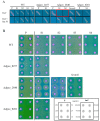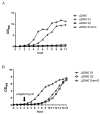Acquisition of Streptomycin Resistance by Oxidative Stress Induced by Hydrogen Peroxide in Radiation-Resistant Bacterium Deinococcus geothermalis
- PMID: 36077162
- PMCID: PMC9456066
- DOI: 10.3390/ijms23179764
Acquisition of Streptomycin Resistance by Oxidative Stress Induced by Hydrogen Peroxide in Radiation-Resistant Bacterium Deinococcus geothermalis
Abstract
Streptomycin is used primarily to treat bacterial infections, including brucellosis, plague, and tuberculosis. Streptomycin resistance easily develops in numerous bacteria through the inhibition of antibiotic transfer, the production of aminoglycoside-modifying enzymes, or mutations in ribosomal components with clinical doses of streptomycin treatment. (1) Background: A transposable insertion sequence is one of the mutation agents in bacterial genomes under oxidative stress. (2) Methods: In the radiation-resistant bacterium Deinococcus geothermalis subjected to chronic oxidative stress induced by 20 mM hydrogen peroxide, active transposition of an insertion sequence element and several point mutations in three streptomycin resistance (SmR)-related genes (rsmG, rpsL, and mthA) were identified. (3) Results: ISDge6 of the IS5 family integrated into the rsmG gene (dgeo_2335), called SrsmG, encodes a ribosomal guanosine methyltransferase resulting in streptomycin resistance. In the case of dgeo_2840-disrupted mutant strains (S1 and S2), growth inhibition under antibiotic-free conditions was recovered with increased growth yields in the presence of 50 µg/mL streptomycin due to a streptomycin-dependent (SmD) mutation. These mutants have a predicted proline-to-leucine substitution at the 91st residue of ribosomal protein S12 in the decoding center. (4) Conclusions: Our findings show that the active transposition of a unique IS element under oxidative stress conditions conferred antibiotic resistance through the disruption of rsmG. Furthermore, chronic oxidative stress induced by hydrogen peroxide also induced streptomycin resistance caused by point and frameshift mutations of streptomycin-interacting residues such as K43, K88, and P91 in RpsL and four genes for streptomycin resistance.
Keywords: Deinococcus geothermalis; chronic oxidative stress; insertion sequence; phenotypic variation; ribosomal protein S12 (RpsL); streptomycin-dependent (SmD) and -resistant (SmR); transposition.
Conflict of interest statement
The authors declare no conflict of interest.
Figures







Similar articles
-
Transposition of insertion sequences by dielectric barrier discharge plasma and gamma irradiation in the radiation-resistant bacterium Deinococcus geothermalis.J Microbiol Methods. 2022 May;196:106473. doi: 10.1016/j.mimet.2022.106473. Epub 2022 Apr 22. J Microbiol Methods. 2022. PMID: 35469976
-
The Transposition of Insertion Sequences in Sigma-Factor- and LysR-Deficient Mutants of Deinococcus geothermalis.Microorganisms. 2024 Feb 4;12(2):328. doi: 10.3390/microorganisms12020328. Microorganisms. 2024. PMID: 38399731 Free PMC article.
-
Impairing methylations at ribosome RNA, a point mutation-dependent strategy for aminoglycoside resistance: the rsmG case.Biomedica. 2014 Apr;34 Suppl 1:41-9. doi: 10.1590/S0120-41572014000500006. Biomedica. 2014. PMID: 24968035
-
Active Transposition of Insertion Sequences in Prokaryotes: Insights from the Response of Deinococcus geothermalis to Oxidative Stress.Antioxidants (Basel). 2022 Feb 28;11(3):481. doi: 10.3390/antiox11030481. Antioxidants (Basel). 2022. PMID: 35326130 Free PMC article. Review.
-
Streptomycin.2021 Sep 15. LiverTox: Clinical and Research Information on Drug-Induced Liver Injury [Internet]. Bethesda (MD): National Institute of Diabetes and Digestive and Kidney Diseases; 2012–. 2021 Sep 15. LiverTox: Clinical and Research Information on Drug-Induced Liver Injury [Internet]. Bethesda (MD): National Institute of Diabetes and Digestive and Kidney Diseases; 2012–. PMID: 31644128 Free Books & Documents. Review.
Cited by
-
Status and analysis of undetected plague cases in Yunnan Province, China.Front Public Health. 2024 Sep 4;12:1408025. doi: 10.3389/fpubh.2024.1408025. eCollection 2024. Front Public Health. 2024. PMID: 39296840 Free PMC article.
-
Nanopore-based targeted sequencing (NTS) for drug-resistant tuberculosis: an integrated tool for personalized treatment strategies and guidance for new drug development.BMC Infect Dis. 2025 Jul 1;25(1):861. doi: 10.1186/s12879-025-11227-4. BMC Infect Dis. 2025. PMID: 40596923 Free PMC article.
References
MeSH terms
Substances
Supplementary concepts
Grants and funding
LinkOut - more resources
Full Text Sources

